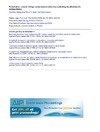Identificador persistente para citar o vincular este elemento:
https://accedacris.ulpgc.es/jspui/handle/10553/41837
| Campo DC | Valor | idioma |
|---|---|---|
| dc.contributor.author | Shibanuma, Toshihiko | en_US |
| dc.contributor.author | Maier, Stefan A. | en_US |
| dc.contributor.author | Albella, Pablo | en_US |
| dc.date.accessioned | 2018-09-04T14:52:18Z | - |
| dc.date.available | 2018-09-04T14:52:18Z | - |
| dc.date.issued | 2018 | en_US |
| dc.identifier.issn | 0003-6951 | en_US |
| dc.identifier.uri | https://accedacris.ulpgc.es/handle/10553/41837 | - |
| dc.description.abstract | Metasurfaces built of high refractive dielectric nanostructures could play a key role in controlling the electromagnetic wave propagation, due to their low energy losses and their ability to excite not only electric but also magnetic resonances. In this study, we theoretically and experimentally demonstrate that an array of high-index dielectric nanodimers can perform as tuneable metasurfaces that can be switched from a high transmitter to a high reflector, by just changing the linear polarization of excitation. The incident polarization alters the hybridization mode of the excited electric and magnetic dipoles in the dimer, and this leads to either spectral overlap or separation of the two dipoles. The hybridization of the electric and magnetic modes modifies the effective permittivity and permeability of the tuneable dielectric metasurface, exhibiting the high transmission and reflection that can be easily switched by simply changing the linear polarization. | en_US |
| dc.language | eng | en_US |
| dc.relation.ispartof | Applied physics letters | en_US |
| dc.source | Applied Physics Letters [ISSN 0003-6951], v. 112 (6), 063103 | en_US |
| dc.subject | 221201 Campos electromagnéticos | en_US |
| dc.subject | 2202 Electromagnetismo | en_US |
| dc.subject.other | Field Enhancement | |
| dc.subject.other | Resonances | |
| dc.subject.other | Plasmonics | |
| dc.title | Polarization control of high transmission/reflection switching by all-dielectric metasurfaces | en_US |
| dc.type | info:eu-repo/semantics/Article | es |
| dc.type | Article | es |
| dc.identifier.doi | 10.1063/1.5018783 | |
| dc.identifier.scopus | 85041706182 | |
| dc.identifier.isi | 000424703200033 | - |
| dc.contributor.authorscopusid | 26656961400 | |
| dc.contributor.authorscopusid | 7201635833 | |
| dc.contributor.authorscopusid | 14032984700 | |
| dc.identifier.issue | 6 | - |
| dc.relation.volume | 112 | - |
| dc.investigacion | Ingeniería y Arquitectura | en_US |
| dc.type2 | Artículo | en_US |
| dc.contributor.daisngid | 30402321 | |
| dc.contributor.daisngid | 28935 | |
| dc.contributor.daisngid | 924063 | |
| dc.contributor.wosstandard | WOS:Shibanuma, T | |
| dc.contributor.wosstandard | WOS:Maier, SA | |
| dc.contributor.wosstandard | WOS:Albella, P | |
| dc.date.coverdate | Febrero 2018 | |
| dc.identifier.ulpgc | Sí | es |
| dc.description.sjr | 1,331 | |
| dc.description.jcr | 3,521 | |
| dc.description.sjrq | Q1 | |
| dc.description.jcrq | Q1 | |
| dc.description.scie | SCIE | |
| item.fulltext | Con texto completo | - |
| item.grantfulltext | open | - |
| crisitem.author.orcid | 0000-0001-7531-7828 | - |
| crisitem.author.fullName | Albella Echave, Pablo | - |
| Colección: | Artículos | |
Citas SCOPUSTM
36
actualizado el 08-jun-2025
Citas de WEB OF SCIENCETM
Citations
36
actualizado el 08-jun-2025
Visitas
42
actualizado el 16-sep-2023
Descargas
265
actualizado el 16-sep-2023
Google ScholarTM
Verifica
Altmetric
Comparte
Exporta metadatos
Los elementos en ULPGC accedaCRIS están protegidos por derechos de autor con todos los derechos reservados, a menos que se indique lo contrario.
